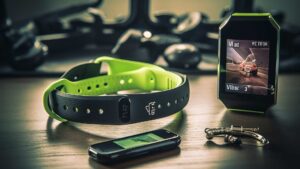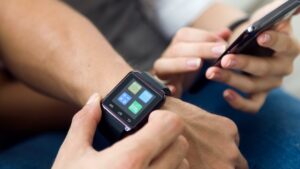Wearable devices technology is developing quickly, blending productivity, fashion, health, and many other aspects into gadgets that are not only useful but also becoming more and more necessary. With notable developments in artificial intelligence, health monitoring, augmented reality, and sustainability, new technology wearables are pushing the envelope in 2024. These are the leading wearable technologies that will be popular in 2024.
Nonetheless, the term wearable devices refers to electronic gadgets made to be worn on the body as accessories or integrated into attire to carry out particular, frequently sophisticated tasks including monitoring health indicators, promoting communication, offering entertainment, and increasing productivity.
To gather and send data in real time and let users keep an eye on many facets of their everyday lives, they usually include sensors, CPUs, and connection features.
Key Characteristics of Wearable Devices Technology

Portability and Comfort: Wearable technology devices are meant to be lightweight, modest, and ergonomic, allowing users to wear them throughout the day without discomfort.
Continuous Monitoring: Outfitted with sensors, they continuously monitor biometric information like blood pressure or glucose levels as well as metrics like heart rate, movement, and sleep patterns.
Data Connectivity: To provide real-time data sync and alerts, the majority of wearables link via Bluetooth, Wi-Fi, or cellular connections to other devices, such as PCs, smartphones, or cloud platforms.
Interactive Functionality: Touchscreens, voice commands, gestures, and augmented reality (AR) overlays are some of the ways that many wearables and the latest tech gadgets enable interaction.
Battery Efficiency: Because wearables are made to last for extended periods, they frequently use battery technology that is tailored to minimize the need for regular charging.
Technology wearables device examples include;
- Fitness bands and smartwatches: monitor fitness indicators, control alerts, and provide simple communication.
- Smart Glasses: For entertainment, productivity, and navigation, uses augmented reality.
- Biometric Earbuds: Provide audio capabilities and monitor health indicators like heart rate and oxygen saturation.
- Smart clothing: incorporates sensors into textiles to provide sophisticated performance and health tracking.
- Medical wearables: include skin patches for long-term health monitoring and continuous glucose monitors (CGMs).
Nonetheless, Wearable technology essentially bridges the gap between the digital and physical worlds by using miniature technology to improve the user’s experience through data gathering, interaction, and real-time insights.
List of top Wearable devices technology

Here is the list of the best and latest tech gadgets that are revolutionizing the ways of life.
Wearable AI-Powered Devices for Instantaneous Health Information
Wearable new gadget tech for health has been revolutionized by AI. The capabilities of today’s latest tech gadgets extend beyond fitness tracking and heart rate monitoring. For instance, by identifying minute variations in bodily measurements, some of the newest gadgets offer continuous glucose monitoring, hydration tracking, and even early disease detection. Real-time analysis of various data streams by sophisticated machine learning algorithms provides users with actionable insights and health warnings.
Prominent Equipment:
- The Dexcom G7 with Freestyle Libre 3 for real-time glucose monitoring.
- Oura Ring Gen 4, uses AI-powered health insights to track body temperature, heart rate variability, and sleep.
AR-Powered Smart Glasses: The Upcoming Development
In 2024, augmented reality (AR) smart glasses are finally beginning to fulfill their potential. Professionals in the fields of logistics, healthcare, and even commonplace use cases like navigation might benefit greatly from their ability to project information into the user’s range of vision. These technology wearables smart glasses are speedier and provide sharper, more immersive visuals than earlier models due to 5G and upgraded optical displays.
Important characteristics and latest tech gadgets:
- Meta’s Quest 4: Integrates AR and VR for social, professional, and gaming uses.
- Nreal Air: With augmented reality overlays for real-time navigation and alarms, Nreal Air is stylish and useful for regular users.
Biometric Earphones for Monitoring Holistic Health
Earbuds have historically been used as audio devices, but they are gradually becoming fully functional new gadget tech wearable health devices. Biometric earbuds combine cutting-edge health monitoring with audio technology, using sensors that can identify heart rate, oxygen saturation, and even stress levels through voice analysis. By sensing stress indicators like the user’s voice pitch and tone, several of these earbuds can provide input on mental health.
Top Wearable technology devices:
- Heart-rate-tracking Bose Smart Earbuds.
- Fourth-generation Amazon Echo Buds: sophisticated voice recognition aspects
Smart Clothes: Fashionable Wearable devices technology
Although smart clothing has long been a fascinating field of technology wearables, it is currently gaining popularity and accessibility. Sensors built into clothing items, such as shirts and jackets, can track respiration rates, posture, and body temperature. Additionally, some models generate energy from body movement using conductive textiles, which can be utilized to power tiny gadgets.
Popular devices:
- Hexoskin Smart Shirts: Incorporated fabric sensors that monitor movement, respiration rate, and heart rate.
- Google’s Levi’s Jacquard: a smart jacket that lets users use basic motions to manage their cellphones.

Wearable Sleep Technology for Restful Sleep
Wearable sleep-tech devices are becoming more and more popular as people realize how important sleep is. Besides tracking sleep stages, many latest tech gadgets now provide sleep-enhancing capabilities like guided sleep meditations and haptic feedback that gently wakes the user during light sleep cycles. To give feedback on how the environment affects the quality of sleep, advanced models additionally keep an eye on the ambient room conditions.
Famous technology wearables
- Whoop 4.0: Daily insights on stress and recuperation, as well as thorough sleep tracking.
- Muse S (2nd Gen): EEG-sensory headband that provides sleep meditation and tracks brain activity.
Eco-Friendly Wearables: Combining Style with Green Technology
Customers and brands alike are placing an increasing emphasis on sustainability, which has led to the development of Wearable devices technology with recyclable components, eco-friendly materials, and longer battery life to cut down on waste. Certain new gadget tech wearables can even be charged by themselves using the kinetic energy produced by movement or by renewable energy sources like solar power.
Market examples include:
- Garmin and Citizen have solar-charged smartwatches that use sunshine to prolong their battery life.
- The Apple Watch Ultra features a battery-saving mode.
Advanced Wearable Technology for Pain Management and Therapy
Additionally, Wearable technology devices are advancing medicinal uses for pain management. Technology wearables that look like belts, wristbands, or patches are starting to incorporate devices like transcutaneous electrical nerve stimulation (TENS) to provide users with on-demand pain treatment. These devices block pain impulses at the nerve level, offering focused relief for chronic pain syndromes.
Innovative Devices:
- ReliefBand Premier: Uses electrical pulses to help control pain and nausea.
- TheraBelt: Perfect for managing chronic pain, this device uses TENS and heat to relieve lower back pain.
Wearable Brain-Computer Interfaces (BCI)
With wearables that let people operate gadgets with just their thoughts, BCI technology is developing quickly. These new gadget techs are being evaluated for hands-free control of robotic devices, laptops, and smartphones, although they are still in the early stages of development. For those with mobility disabilities, these technology wearables may be revolutionary, opening up new possibilities for independence and accessibility.
Emerging Technology:
- By identifying brain activity, the Neurable Headband enables users to manage basic smartphone activities.
- Presently under development, NextMind will facilitate accessibility apps, gaming, and other uses.
Patches on the Skin for Ongoing Health Monitoring
Skin patches that allow continuous monitoring of multiple health parameters and adhere to the skin like a sticker are becoming more and more common. Skin patches, in contrast to conventional technology wearables, are discrete and worn all day, even when swimming or sleeping. These patches provide athletes with a real-time picture of their general health by tracking blood pressure, oxygen levels, and even lactic acid levels.
Innovative Products:
- Abbott Libre Sense: Monitors lactic acid and blood sugar levels in athletes.
- The BioStamp monitors movement, heart rate, and muscular activity.
Wearable Augmentation Exoskeletons
Although they are not new, technology wearables exoskeletons are becoming more widely available for usage in industry and even by consumers due to developments in lightweight, powered designs. By supporting and enhancing human movement, these gadgets help people with mobility problems or lift large objects. Exoskeletons have become lighter, more comfortable to wear, and more reasonably priced as battery technology advances.
Pioneering Innovations:
- EksoVest: An industrial worker’s powered upper-body exoskeleton.
- Samsung GEMS: An exoskeleton for the lower body designed for older and less mobile people.
Nonetheless, Wearable devices technology in 2024 will be distinguished by its adaptability, customization, and ability to provide real-time insights regarding productivity, quality of life, and health.
Technology wearables are gradually becoming essential instruments that fit in perfectly with everyday life due to developments in a variety of sectors, including augmented reality, artificial intelligence, sustainable design, and therapeutic uses.
As these Wearable devices technology develop, they are not only making life easier, but they are also opening up new avenues for people to comprehend and improve their well-being.













